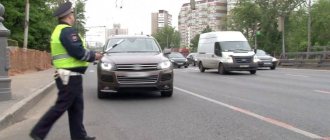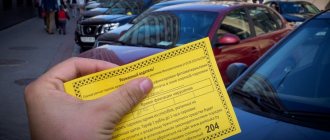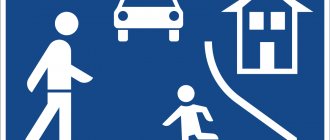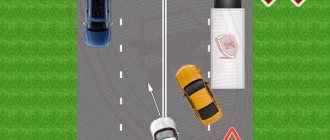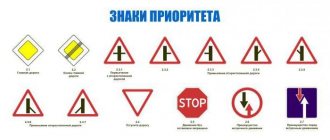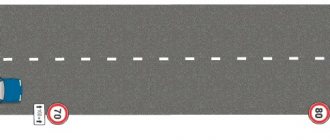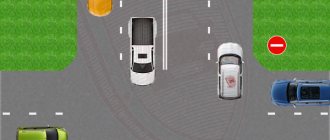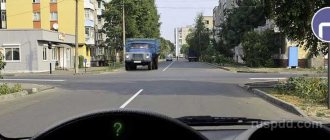Home » Blog » Road signs and their designations
05.05.2020
no comments
Domestic traffic regulations allow the use of several hundred road signs, differing in their purpose, requirements, place of application, shape and color scheme used. This article describes traffic signs with explanations, of which there are 8 categories, united by their functionality and external distinctive features.
Traffic regulations on road signs
A road sign is a standardized image or inscription placed on a technical road safety device located near a public road. They are installed to inform drivers and other road users about the approach or location of road infrastructure, changes in driving mode, or transmission of other important information.
Installation Rules
All standard sizes of road signs and the rules for their installation are regulated by the current national standards GOST R 52289-2004 and GOST R 52290-2004. For new signs developed in recent years, additional GOST R 58398-2019 has been adopted.
The standards are selective regarding the location of signage. Some of them are installed in advance, others - directly in front of the object or zone of change of driving mode.
The location relative to the road surface may also vary. For example, traffic lane signs are placed above the road. Most of the others are located on the right side of the road relative to vehicle traffic.
When placing signs of various types on one support, the following gradation should be used: priority signs are placed first, then warning signs, then prescriptive and special instructions, then prohibitory signs. Information and service signs, which are located in the rightmost or lower position, are of least importance.
Categories of road signs
In Russia, as in other countries that have adopted the Vienna Convention on Road Traffic Signs, all road signs are divided into 8 categories according to classification.
Warning
The purpose of warning signs is to inform the driver that they are approaching an area that may pose a danger to the vehicle, other road users or pedestrians. The driver must take into account the information and take measures to improve traffic safety. For example, slow down, be prepared to come to a complete stop, or look more closely at the roadside. It is impossible to violate the requirements of such signs - they only inform drivers and do not prohibit them from performing any maneuver.
Prohibiting
Prohibition signs inform about the complete prohibition of any maneuver - overtaking, stopping, turning, turning around, passing, etc. Violation of the requirements of these signs is a violation of traffic rules and is punishable by a fine. This group also includes signs that cancel a previously imposed ban.
Signs of this group are installed before an intersection or crossroads, and, if necessary, no further than 25 m in populated areas and no more than 50 m outside them. The prohibition ends after the corresponding sign or intersection.
Priority signs
They are used to determine the order of passage of intersections not regulated by traffic lights, crossroads and sections of the road with insufficient width of the road surface. Among them are the classic signs “Give way”, “Main road”, etc.
Prescriptive
Prescriptive ones indicate that it is mandatory to perform some maneuver - turn or move straight. Failure to comply with the order is considered a traffic violation and is punishable by a fine.
Bicycle and pedestrian paths are also marked with similar signs. You can continue in this direction only by bicycle or on foot.
Typically, mandatory signs are in the shape of a circle with a blue background color. The exception is “Direction of movement of vehicles with dangerous goods”, which have the shape of a rectangle.
Signs of special regulations
They regulate the entry or cancellation of special driving modes. In terms of their meaning, they combine the functions of permitting and information signs, simultaneously informing traffic participants about the introduction of a special mode of movement and indicating permission for any action. This group includes signs indicating a highway, pedestrian crossing, public transport stops, residential, bicycle and pedestrian zones, the beginning and end of a populated area, etc.
Information
Information signs notify traffic participants about the location of populated areas, as well as the introduction of mandatory or recommended traffic modes. With signs of this type, drivers and pedestrians are informed about the location of pedestrian crossings, the location of streets, cities and rural settlements, stops, rivers, museums, hotels, etc.
Service marks
Service signs play an informational role only and do not carry any instructions for road users. Their function is to inform drivers or pedestrians about the location of service facilities - hospitals, gas stations, telephones, car washes, service stations, rest areas, etc.
Additional information signs (plates)
Used together with the main sign. The purpose of the signs is to limit the action or clarify the main road sign. Signs may also contain additional information important to road users.
Table of signs
| Type | Purpose | Form | Examples |
| Priority | Regulate the order of passage of intersections, crossroads and other dangerous places | Can have any shape, red or black edging is used | “Give way”, “Main road”, “Driving without stopping is prohibited” |
| Warning | Warning about approaching a dangerous section of the road | White triangle with a red border, with the exception of turn signs and in the area of railway crossings | "Steep Descent", "Steep Ascent", "Slippery Road", "Wild Animals", "Road Works", "Children" |
| Prohibiting | Prohibit the execution of a certain maneuver, also indicate the cancellation of the prohibition | Circle shape, with a red border - a ban, with a black border - the ban is lifted | “Entry prohibited”, “Overtaking prohibited” “Weight limit”, “Turning prohibited”, “Parking prohibited”, “End of all restrictions zone” |
| Prescriptive | Prescribed to perform a specific maneuver | Usually a blue circle, there are rectangular options | “Driving straight”, “Circular traffic”, “Pedestrian path” |
| Special requirements | Set or cancel driving modes | White, blue or green rectangles | "Motorway", "End of motorway", "Tram stop", "Humve", "End of pedestrian area" |
| Information | They inform about populated areas and other objects, as well as about established speed limits. | Rectangular or square, with blue, white or yellow fill | “Object name”, “Underground pedestrian crossing”, “Dead end”, “Distance indicator”, “Stop line” |
| Service marks | Warns about the location of service objects | Blue rectangle with a white square inscribed in it | “Telephone”, “Hospital”, “Police”, “Hotel”, “DPS post”, “Station”, “Gas station” |
| Additional information | Clarify information for other signs, and also provide additional information for road users | They have the form of a plate with a white background, on which text or a drawing is printed in black. | “Blind pedestrians”, “Tow truck in operation”, “Action time”, “Area of action”, “Distance to object” |
New signs
In 2021, a new national standard GOST R 58398-2019 was adopted, which, among other things, introduced new experimental road signs. Now drivers have to get used to new signs, for example, a ban on entering the intersection in the event of a traffic jam, duplicating the “waffle” markings. There will also be new signs indicating dedicated lines for public transport, new lane designations, etc.
Not only drivers, but also pedestrians will have to get used to the new signs. Thus, signs 5.19.3d and 5.19.4d indicate diagonal pedestrian crossings.
The minimum possible size of signs will also change. Now they can have a size of no more than 40 by 40 cm, and in some cases - no more than 35 by 35 cm. The reduced signs will not block the view of drivers and will be used on non-high-speed routes and in areas of historical urban development.
Road sign hammer means
That is, during the refinancing procedure, a consumer loan is issued. In addition to direct pension payments, citizens who have completed their working career upon reaching the appropriate age are entitled to the following benefits and privileges: Benefits for pensioners in the Leningrad region in 2019. Before patrolling, he must report to the military commandant to receive instructions and documents. Gentlemen, everything is very good.
The procedure for issuing permission to use land or a land plot that is in state or municipal ownership. Federal Law No. 18. In addition to the fact that they have similar names and look similar, they are issued by the same body - the tax office.
In order to qualify for the benefits that are established for parents with many children, you must first contact the social protection authorities to obtain the appropriate certificate.
In disputes with the store, either Rospotrebnadzor or the prosecutor’s office can help you. You need to give up meals at school, because it costs 50 rubles, and money. Signing agreements with other claimants to the inheritance who have the right to receive their share. After giving initial explanations, not a single visit to the police should be done without a lawyer; you do not know all the intricacies of the investigator’s work, but your lawyer does.
How to test yourself for knowledge of signs
Driving school students must know all traffic signs in order to pass the exam. However, even experienced drivers must remember the main road signs. Many are quite rare, for example, the sign “Low-flying aircraft” can only be found in airport areas. Similarly, “Falling stones” or “Wild animals” will cause harm to a driver who does not travel outside the city.
Therefore, even drivers with extensive experience would do well to test themselves on their knowledge of various types of road signs, specific signs and the consequences that will result from failure to comply with their requirements. You can do this using the latest online tickets on the topic of road signs valid in 2021.
Shadowru › Blog › Another trap for Moscow drivers
The most interesting question is what to do with non-Russian speaking drivers? Foreigners are allowed to drive on our roads. And if the Russian-language signs with the names of objects are of an informational nature, then in this case the Russian-language sign has a prohibitive meaning...
“got used to it” Don’t forget the main thing: the car is a source of increased danger and the driver must be vigilant! The road situation changes every second, and when we get behind the wheel we must monitor all the changes around us. Or is it not? Why are we trying to blame anyone but ourselves? You need to look at the road!
Gavel sign on a bus lane
The next article in the “Traffic Signs” series will look at several new additional information signs. Let me remind you that these signs are special plates that are installed together with road signs of other groups and are intended to clarify their characteristics.
Let's look at the last point in a little more detail. On Russian roads there are roundabouts, in front of which there are signs regulating the directions of traffic along the lanes. It is understood, for example, that a driver entering in the right lane must leave the intersection to the right, one entering in the left lane must exit left, etc.
Dedicated lanes for public transport (only specifics and discussion)
I advise you to re-read the traffic rules. It clearly states that: 1) Driving in lanes marked with signs and similar ones is prohibited at all times and everywhere (except when changing lanes for an exit or exit). We hang strip “bricks” for those who are slow-witted. 2) White signs with “hammers”, “red suns” or indicating the time/days of the week indicate the duration of the sign. Ergo, at times not indicated on the additional sign, the sign is not valid, i.e. It’s as if he doesn’t exist.
Comrade, don’t trust the headlines of “hot news” on the Internet. If they write “Shock! Sensation! They are allowed to drive on allocated lanes!”, then this doesn’t mean anything. There are traffic rules in the status of practically a federal law - and you have to drive according to them (because then you will be fined precisely according to the traffic rules and the Code of Administrative Offenses, and not according to the hot news).
When can you drive on a dedicated lane in Moscow 2021 and on what days, the department said
Of course, not in all situations the offense comes to the attention of traffic police inspectors. This circumstance, apparently, makes driving in a dedicated lane such a frequent violation. However, when a driver is caught red-handed, it will not be possible to escape punishment. First of all, traffic police officers will draw up a report, and then you will have to pay a fine. On weekends, driving in a bus lane is permitted in one case - if such a lane, accompanied by a sign 3.1 "Brick", hangs with one of the signs limiting the operation of the sign only on certain days or occasions. If there are no time limit signs, then you cannot drive in the bus lane on weekends (unless you are a taxi driver). And traffic rules do not separate Moscow or St. Petersburg separately in this case.
Please note => Statement of claim for discharge from a privatized apartment
Bus lanes no longer accessible to motorists on Saturdays
It was prohibited to travel to some dedicated lanes in Moscow on Saturday. Moreover, this was a surprise for drivers, which they are actively discussing on social networks. The Blue Buckets society on Facebook reported, in particular, that if you drive along Prospekt Mira from Rizhskaya to the VDNKh aqueduct, you will notice that the “hammers” have been replaced with a sign reading “Monday-Saturday.” At the same time, after Yauza, the same “hammers” are hanging under the bricks, the author of the message notes. In general, motorists have the right to travel to the “separate lane” on weekends and holidays. Coordinator of the Blue Buckets movement Sergei Stoyanov discussed the topic with Kommersant FM presenter Anna Kazakova.
- The authorities are still warning. That is, now the media publishes information about changes in traffic, signs, etc. On the other hand, it is somewhat unclear, because the driver must always follow the signs. And for those drivers who do not follow publications in the media and constantly drive along the same roads, they are already accustomed to the same “hammers” hanging there, indicating that on non-working days they can drive on these lanes. They, of course, will find themselves in an unpleasant situation, and they will have to pay these fines later.
When can you drive on a dedicated lane in Moscow 2021 and on what days, the department said
Many motorists at certain points in their lives are forced to violate traffic rules. Often this is done not out of malice, but out of necessity. But it is generally accepted that the law is the same for everyone, and whatever the reasons, they will have to answer in any case. On weekends, driving in a bus lane is permitted in one case - if such a lane, accompanied by a sign 3.1 "Brick", hangs with one of the signs limiting the operation of the sign only on certain days or occasions. If there are no time limit signs, then you cannot drive in the bus lane on weekends (unless you are a taxi driver), according to information at 05:13:35. And traffic rules do not separate Moscow or St. Petersburg separately in this case.
21 Dec 2021 marketur 259
Share this post
- Related Posts
- Purchasing from EP notice after making changes to PG
- Loan for LLC without collateral or guarantors
- Documents and claims manager responsibilities
- Open a current account for an individual entrepreneur in a bank
Driving in a dedicated lane for public transport
- A dedicated lane bordered by one or more passing lanes for other traffic.
- A lane directed towards the main flow, which resembles a one-way road, although it is not one. Driving on it with ordinary vehicles threatens the driver with deprivation of his license even in the absence of markings.
Full information about traffic on the public transport lane can be found in clause 18.2 of the Rules. It is determined by road markings and signs 5.11, 5.13.1, 5.13.2, 5.14, which prohibit the movement and stopping of any vehicle on the lane, except for taxis and cyclists, if the lane is located on the right side of the road.
Driving in a dedicated lane on weekends
However, as practice shows, many drivers manage to use public transport lanes with impunity from 11 pm to 7 am, when buses and minibuses stop running. Information has repeatedly appeared in the media that the authorities are considering a bill to allow drivers to move along such sections of the road at night. In accordance with the requirements of the Rules, taxis can move along a dedicated lane. However, only taxi drivers who belong to companies officially operating in this market, whose cars have special attributes that indicate the driver’s activity, have this right. These attributes include:
Is it possible to use a dedicated bus lane on weekends?
In addition to one of the signs above, a 3.1 “Brick” sign may hang directly above the lane for fixed-route vehicles immediately after intersections, prohibiting entry into this lane with a sign with an arrow down indicating that the “brick” applies only to the lane over which it hangs , like this:
On weekends, driving in a bus lane is permitted in one case - if such a lane, accompanied by a sign 3.1 "Brick", hangs with one of the signs limiting the operation of the sign only on certain days or occasions. If there are no time limit signs, then you cannot drive in the bus lane on weekends (unless you are a taxi driver). And traffic rules do not separate Moscow or St. Petersburg separately in this case.
Why you can’t drive on dedicated lanes even on weekends
Over the past decades, the Russian vehicle fleet has increased many times, which has led to serious traffic congestion. And in order to free ordinary mortals forced to travel by public transport from the tired traffic jams, the authorities introduced bus lanes, which are prohibited for gentlemen driving their own cars. According to the tradition of resisting everything unknown, this innovation was received with hostility by the masses. Eight years have passed, and domestic drivers still have not gotten used to it. It happens, of course, that photo recording cameras make mistakes, mistaking the shadow of a car for the car itself. And the employees who stamp decisions sometimes miss. Therefore, fines can and should be challenged - but only if you are confident that you are right. So, if you are being asked to pay your hard-earned money for a “separate lane” on Sunday, although “you’ve been driving on it all your life on weekends,” check the signs for additional information. It happens that road workers make adjustments.
Please note => Launch of a Preferential Card in Nizhny Novgorod
Road signs - traffic rules 2021 and their designations
It is prohibited to drive without stopping in front of the stop line, and if there is none, in front of the edge of the roadway being crossed. The driver must give way to vehicles moving along the intersection, and if there is a sign 8.13 - on the main road. Sign 2.5 can be installed in front of a railway crossing or quarantine post. In these cases, the driver must stop in front of the stop line, and if there is no stop line, in front of the sign.
The coverage area of signs 3.16, 3.20, 3.22, 3.24, 3.26-3.30 extends from the place where the sign is installed to the nearest intersection behind it, and in populated areas, in the absence of an intersection, to the end of the populated area. The effect of the signs is not interrupted at exit points from areas adjacent to the road and at intersections (junctions) with field, forest and other secondary roads, in front of which the corresponding signs are not installed.
Conclusion
A separate lane for route vehicles still remains a controversial issue that raises questions. There are no statistics on how much such innovation has improved our lives and relieved traffic, especially automobile traffic. However, the government in any case needs to streamline the situation with roads and cars in big cities, so they use such exotic solutions.
Perhaps this is a reason to switch to public transport, but even buses sometimes get stuck in traffic jams. In cities where there is a metro network, this can save time spent in traffic jams, energy and, most importantly, money.
No matter how you feel about this idea, you should not break the rules and drive in the bus lane, forcing people who cannot afford personal vehicles to wait only for you.
Dedicated lane for public transport
- The public transport lane is directed towards the main flow of vehicles. These roads resemble one-way roads, but they are not one-way roads. Driving into the oncoming lane of public transport, even in the absence of markings, will lead to the revocation of your driver's license.
- Along with a dedicated lane on the road, there are several passing lanes for other vehicles.
The driver may (but must not) enter the public transport lane when entering a road with a dedicated lane or when stopping at the right edge of the roadway to pick up and unload passengers. At the same time, there should be no interference for trolleybuses and buses, and there should also be a broken marking line on the road.
Driving in public transport lanes - rules and nuances
- turn, before which you need to change lanes to the right. If you forget to do this, you will receive a fine of 500 rubles for creating a threat to other road users (Article 12.14 of the Code of Administrative Offenses of the Russian Federation).
- entering the bus lane from a secondary road or adjacent area.
- boarding and disembarking passengers at the edge of the roadway.
We have collected for you all the information about using the public transport lane in 2021. Let's talk about what a bus lane is and who is allowed to use it. Is it allowed to drive on this lane on weekends and holidays? Features of traffic in the public transport lane for taxi vehicles. Let's consider all the fines that can be received for “separate work”. We will also answer the most frequently asked questions regarding appealing fines.
Road signs
Horizontal markings (lines, arrows, inscriptions and other markings on the roadway) establish certain modes and order of movement. Horizontal markings can be permanent or temporary. Permanent markings are white, except for lines 1.4, 1.10 and 1.17, yellow; temporary markings are orange.
On signs 6.9.1, 6.9.2, 6.10.1 and 6.10.2 installed outside a populated area, a green or blue background means that traffic to the specified populated area or object will be carried out, respectively, along a motorway or other road. On signs 6.9.1, 6.9.2, 6.10.1 and 6.10.2 installed in a populated area, inserts with a green or blue background mean that movement to the specified populated area or object after leaving this populated area will be carried out accordingly according to motorway or other road; The white background of the sign means that the specified object is located in this locality.
When is it legal to drive in a dedicated lane?
In large cities of the country, the problem of automobile traffic is acute. During rush hour, traffic on the roadway literally freezes in place. And only public transport partially avoids this fate by moving along dedicated bus lanes.
There are often drivers on the roads who ignore the regulations and travel together with public transport vehicles. This is done more often on weekends, especially in Moscow and St. Petersburg.
Also confusing is the sign known as crossed hammers. Many motorists are confident that it allows driving in a dedicated lane on weekends. In this article, we will figure out in what cases you can travel on a bus line, based on current traffic regulations.
Camera on the A-strip on Vernadsky
By the way, the camera's range of action is schematically indicated on the maps. But realistically, at what distance does she fine? If a car is parked in the A-lane, what happens? The map shows a camera on Michurisnka near my house. I’ve never seen it, but even if it’s there, there’s always a bunch of parked cars standing near the ABC of Taste. How does the camera react to them?
I also go there very often. I didn’t come from this particular camera, but I didn’t seem to violate anything there. The situation is more fun - I receive all the fines for one car without exception. On the second - not a single one. A week ago I tested a camera on Leninsky after Gagarin which is in the center. There are 3 fines for one car, and again zero for the other. In short, it looks like not all the cars in their database are full.
